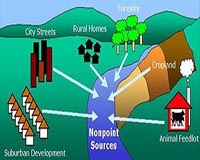| . |  |
. |
Washington DC (SPX) Sep 02, 2009 Steep reductions in the abundance of fish, shellfish, and other aquatic fauna in recent centuries are not restricted to animals that live in the sea: historical records show that species in rivers and lakes worldwide also experienced sharp declines. Yet the significance of these declines in freshwater species is frequently overlooked by natural resource managers, according to an article in the September 2009 issue of BioScience. Authors Paul Humphries and Kirk Winemiller argue that as a result of this neglect of historical records, watershed planning is often built on estimates of baseline abundances of fish, freshwater mussels, and beavers that are much lower than actual past abundances. Planners consequently underestimate the likely far-reaching effects such animals had on their ecosystems before European colonization. Although precise historical numbers cannot be known, written accounts dating from the 1600s suggest that abundances were much greater than they are today. Travelers and diarists reported rivers so full of fish that a spear thrown into the water only rarely missed one, salmon runs that spanned the whole width of a river, and fish so plentiful that they were used as pig feed. Humphries and Winemiller point out that European colonizers in North America and Australia, in particular, could easily move inland from coastal communities to supplement their seafood with food taken from freshwaters. Then, within a few decades, they started constructing weirs and mills that impeded the migration of fishes and put further pressure on stocks. Stocks of fish and shellfish declined rapidly after colonization. The effects of this early loss of wildlife on the river ecosystems, the authors contend, has not been adequately considered. Freshwater systems that have been little exploited seem to confirm the strong effects of fishing pressure in freshwater systems. Humphries and Winemiller cite the case of rivers in the Lake Eyre Basin, in central Australia, where fish are much more abundant than in comparable systems that are more heavily exploited. Humphries, of Charles Sturt University in New South Wales, Australia, and Winemiller, of Texas A and M University in College Station, support the reintroduction of top predators and keystone species recently extirpated from freshwaters, and urge the creation of freshwater protected areas. Some of these protected areas could be used for restoration experiments in which the effects of reintroduced species could be explored. Share This Article With Planet Earth
Related Links American Institute of Biological Sciences Water News - Science, Technology and Politics
 Homes Pollute Our Water
Homes Pollute Our WaterWashington DC (SPX) Aug 26, 2009 They say there's no place like home. But scientists are reporting some unsettling news about homes in the residential areas of California. The typical house there - and probably elsewhere in the country - is an alarming and probably underestimated source of water pollution, according to a new study reported today at the 238th National Meeting of the American Chemical Society. In the ... read more |
|
| The content herein, unless otherwise known to be public domain, are Copyright 1995-2009 - SpaceDaily. AFP and UPI Wire Stories are copyright Agence France-Presse and United Press International. ESA Portal Reports are copyright European Space Agency. All NASA sourced material is public domain. Additional copyrights may apply in whole or part to other bona fide parties. Advertising does not imply endorsement,agreement or approval of any opinions, statements or information provided by SpaceDaily on any Web page published or hosted by SpaceDaily. Privacy Statement |